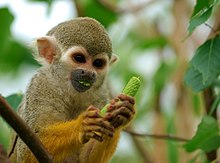| Squirrel monkeys[1] | |
|---|---|

| |
| Common squirrel monkey | |
| Scientific classification | |
| Domain: | Eukaryota |
| Kingdom: | Animalia |
| Phylum: | Chordata |
| Class: | Mammalia |
| Order: | Primates |
| Suborder: | Haplorhini |
| Infraorder: | Simiiformes |
| Family: | Cebidae |
| Subfamily: | Saimiriinae Miller, 1912 (1900) |
| Genus: | Saimiri Voigt, 1831 |
| Type species | |
| Simia sciurea | |
| Species | |
| Synonyms | |

Squirrel monkeys are New World monkeys of the genus Saimiri. Saimiri is the only genus in the subfamily Saimiriinae. The name of the genus is of Tupi origin (sai-mirím or çai-mbirín, with sai meaning 'monkey' and mirím meaning 'small')[3] and was also used as an English name by early researchers.[4][5]
Squirrel monkeys live in the tropical forests of Central and South America in the canopy layer. Most species have parapatric or allopatric ranges in the Amazon, while S. oerstedii is found disjunctly in Costa Rica and Panama.
There are two main groups of squirrel monkeys recognized. They are differentiated based on the shape of the white coloration above the eyes. In total there are five recognized species.[6][7] Squirrel monkeys have short and close fur colored black at the shoulders, yellow or orange fur along the back and extremities, and white on the face.[8]
Squirrel monkeys have determined breeding seasons which involve large fluctuations in hormones and there is evidence of sexual dimorphism between males and females.[9]
Squirrel monkeys can only sweat through the palms of their hands and feet. This can have the effect of making their hands and feet feel damp to the touch. Squirrel monkeys must make use of other thermoregulation techniques such as behavioral changes and urine washing. [10] These monkeys live in habitats of high temperatures and high humidity, making it essential for them to maintain proper osmoregulation if conditions pass certain thresholds.[11] Color vision studies have also been performed on squirrel monkeys for the purpose of better understanding vision ailments in humans.[12]
The common squirrel monkey is commonly captured for the pet trade and for medical research,[13] but it is not threatened. Two squirrel monkey species are endangered: the Central American squirrel monkey and the black squirrel monkey are listed as vulnerable by the IUCN.[6][14]
- ^ Groves, C. P. (2005). Wilson, D. E.; Reeder, D. M. (eds.). Mammal Species of the World: A Taxonomic and Geographic Reference (3rd ed.). Baltimore: Johns Hopkins University Press. pp. 138–139. ISBN 0-801-88221-4. OCLC 62265494.
- ^ a b Saimiri – Paleobiology Database
- ^ Simpson, George Gaylord (1941). "Vernacular Names of South American Mammals". Journal of Mammalogy. 22 (1): 1–17. doi:10.2307/1374677. JSTOR 1374677.
- ^ Palmer, T. S. (1897). "Notes on the Nomenclature of Four Genera of Tropical American Mammals". Proceedings of the Biological Society of Washington. 11: 173–174.
- ^ Leclerc, Georges-Louis, Comte de Buffon (1797). "The Saimiri." In: Barr's Buffon. Buffon's Natural History. pp. 251–252. London: J. S. Barr.
- ^ a b Boubli, J.-P. & Rylands, A.B. (2008). "Saimiri vanzolinii". IUCN Red List of Threatened Species. 2008: e.T19839A9023022. doi:10.2305/IUCN.UK.2008.RLTS.T19839A9023022.en.
- ^ Cite error: The named reference
:1was invoked but never defined (see the help page). - ^ Cite error: The named reference
:2was invoked but never defined (see the help page). - ^ Cite error: The named reference
:3was invoked but never defined (see the help page). - ^ Cite error: The named reference
:4was invoked but never defined (see the help page). - ^ Cite error: The named reference
:5was invoked but never defined (see the help page). - ^ Cite error: The named reference
Neitzwas invoked but never defined (see the help page). - ^ Rhines, C. (2000). "Saimiri sciureus", Animal Diversity Web. Accessed November 26, 2007
- ^ Wong, G.; Cuarón, A.D.; Rodriguez-Luna, E. & de Grammont, P.C. (2008). "Saimiri oerstedii". IUCN Red List of Threatened Species. 2008: e.T19836A9022609. doi:10.2305/IUCN.UK.2008.RLTS.T19836A9022609.en.